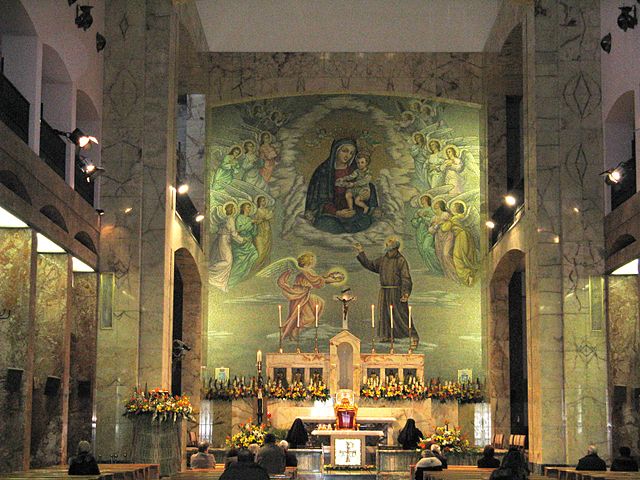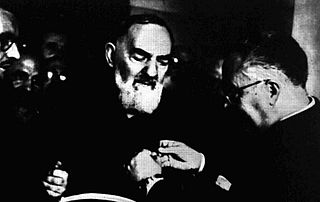I think it is safe to say that a mystique of sorts has evolved surrounding the beloved man popularly known as Padre Pio. The fact that since 2002, he has been numbered among the canonized saints of the Catholic Church, at times appears to be a mere afterthought.
As is often the case with those of intense spirituality and innate simplicity of heart and mind, the still waters of Saint Pio did indeed run deep. In fact, these qualities made themselves known quite early in the life of the peasant boy from a southern Italian family of unquestioned devotion to the Catholic faith.
Born on May 25, 1887, Francesco Forgione came into a close, loving family of farmers just getting by materially but greatly blessed in spiritual gifts. Daily Mass, group recitation of the rosary, and a true love for the faith formed the foundation of their simple family and community life. All things, even sorrows such as the loss of two infants, were accepted as manifestations of God’s will for their lives. Francesco himself struggled with ill health throughout his long life, from his earliest years onward.
As a very young child, Francesco developed a special closeness to Jesus. At age ten, he expressed his wish to become a priest; specifically, a Franciscan friar. Since his education was limited, he required tutoring before entering the Franciscan Order of Friars Minor Capuchin at age 15. He took the name Pio in honor of the patron saint of his home city of Pietrelcina – Saint Pius V.
Fra Pio’s childhood dream was realized on ordination day, August 10, 1910. Within a month’s time, the workings of God would make themselves evident in his life in a most dramatic way. It was not the suffering from Christ’s wounds on his hands and feet, manifested during prayer one September day, that distressed Padre Pio; only their visibility. He desired suffering but preferred to have it in secrecy. After eight years, Jesus did answer his prayer that the stigmata marks disappear for a time. The pain in his hands and feet remained, intense and unending.
Padre Pio was sent home to Pietrelcina from 1911 to late 1916 due to recurring health issues. He ministered there until reassigned to the friary at San Giovanni Rotondo in the Gargano Mountains. A brief stint in the Italian army during World War I ended when Padre Pio was hospitalized for continuing health problems. He returned to San Giovanni Rotondo, where he would remain for the rest of his life.
The visible wounds of Christ to hands and feet, now including a piercing wound in his side, returned to Padre Pio in the late summer of 1918. This manifestation occurred just a month after he had offered himself as a victim in prayer for the end of the war. Like his Seraphic Father, Saint Francis of Assisi, Padre Pio’s intense love for Jesus unified them in the most dramatic sense.
Besides the stigmata, other well-known aspects of Padre Pio’s life in religion were his long hours spent hearing confessions, ability to “read souls,” profound reverence while celebrating Mass, and countless healings of various types. He espoused five rules for spiritual growth: weekly confession, daily Holy Communion, spiritual reading, meditation, and examination of conscience twice daily.
Something that has not been greatly publicized is the voluminous correspondence Padre Pio maintained with numerous religious and lay people over the course of many years. His correspondents included his own spiritual director priests and many “spiritual sons and daughters” to whom he wrote letters of counsel and encouragement.
A number of these missives are recorded in a volume entitled Padre Pio’s Spiritual Direction for Every Day edited by Gianluigi Pasquale. One letter quoted to a fellow priest in 1917 concerns suffering: “The heavenly Father is still having me participate in the sufferings of his only-begotten Son, including physically. That suffering is so intense it cannot be described or imagined. I do not know whether it is through lack of strength or through some fault of my own that, when I am in that state, I cry involuntarily like a baby.”
Difficult as they were, Padre Pio’s long years of suffering on many levels were relieved at times with periods of intense joy. He loved interacting with God’s people, took great delight in the beauties of nature, and lived to see his dream of a hospital realized atop Mount Gargano. Deeply united with Jesus, his experiences of ecstasy in prayer strengthened him to endure constant physical pain, and to thwart the assaults of the evil one against his person and his spirit.
Padre Pio went home to God on September 23, 1968. He was canonized by St. John Paul II on June 16, 2002.
An excerpt from a 1915 letter to one of Padre Pio’s “spiritual daughters” provides a fitting closing: “I live through Jesus Christ, I live for his glory, I live to serve him, I live to love him. When God brings our lives to an end, the sentiment or feeling that we should have is exactly the feeling of someone who receives a reward after working hard or a crown after battle … Let us adore him and dispose our wills always and in all things to be conformed to God’s will.”
Saint Pio, pray for us!
© All Rights Reserved, Living His Life Abundantly®/Women of Grace® http://www.womenofgrace.com


